DRUMS COMMONLY ENCOUNTERED IN RECREATIONAL, COMMUNITY DRUM CIRCLES
[NB: This site covers drums (membranophones) only, although other percussion instruments are ubiquitous in drum circles]
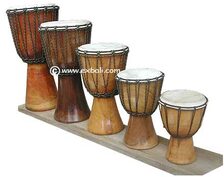
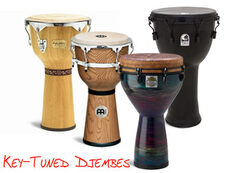 DJEMBES are goblet-shaped drums that originated in Africa. Djembes are ubiquitous in drum circles. They come in lots of different sizes; for most adults playing traditionally (with the drum on the ground in front of the seated player, tipped forward, between the player's legs), drums that are about 24 inches high are about right. Djembes that are smaller than 20 inches high are more appropriate for children, although when they are played nontraditionally (e.g., held in the lap like a doumbek, or held between the knees) small djembes can sound just as good as large ones, and they are lighter and easier to carry than the larger ones.
DJEMBES are goblet-shaped drums that originated in Africa. Djembes are ubiquitous in drum circles. They come in lots of different sizes; for most adults playing traditionally (with the drum on the ground in front of the seated player, tipped forward, between the player's legs), drums that are about 24 inches high are about right. Djembes that are smaller than 20 inches high are more appropriate for children, although when they are played nontraditionally (e.g., held in the lap like a doumbek, or held between the knees) small djembes can sound just as good as large ones, and they are lighter and easier to carry than the larger ones.
Rope-tuned djembes, such as those on the left, are considered more authentic, but may be hard to tune and keep in tune. Key-tuned djembes, such as those on the right, usually are made of synthetic materials and thus are lighter in weight; the heads are impervious to weather; and they are easier to tune than rope-tuned ones (but tend to need tweaking more often)..
The photo below shows a traditional, rope-tuned African djembe with a wooden shell and a goatskin head.
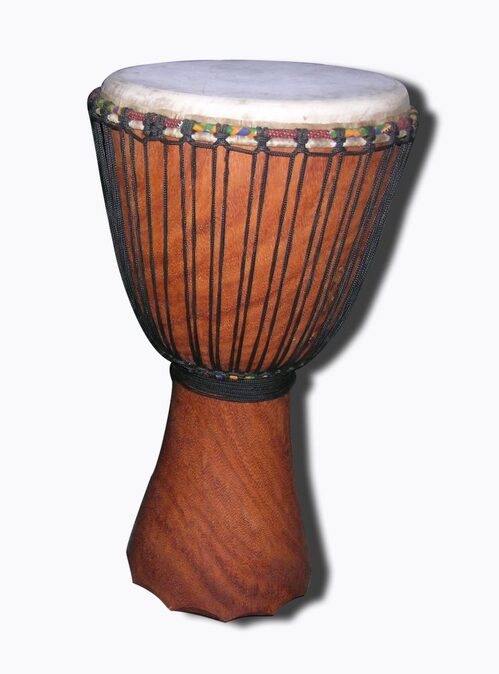
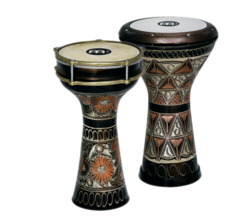
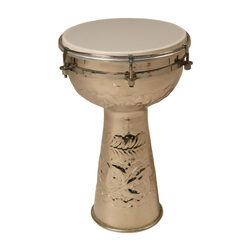 DOUMBEKS are goblet-shaped drums found all over the Middle East, northern Africa, southern Europe, and in places populated by emigrés from those regions. They are quite popular in drum circles, and make excellent instruments with which to accompany dancers.
DOUMBEKS are goblet-shaped drums found all over the Middle East, northern Africa, southern Europe, and in places populated by emigrés from those regions. They are quite popular in drum circles, and make excellent instruments with which to accompany dancers.
Instruments in the doumbek family range widely in size. Shell materials range from ceramic, through wood, and various types of metal. The heads can be synthetic or animal skin, with fish and reptiles as likely to involuntarily provide the skins as mammals. Natural skin heads are usually tied on, and may have to be replaced often. They are difficult to keep in tune, so the professional player needs to have one drum to play, and additional drums or heads (plus an assistant to do the work) being dried out to be put back in tune; each drumhead may remain playable only for short periods up to an hour.
The Meinl instruments (above left) are a darabuka and an Alexandrian doumbek, representing drums played in the "Turkish" style (darabuka) and in the "Egyptian" style (Alexandrian doumbek). The instrument pictured above right represents an inexpensive embossed metal doumbek. The synthetic heads on the above drums are tuned using pliers or Allen wrenches. The picture below shows a ceramic doumbek with a natural head.
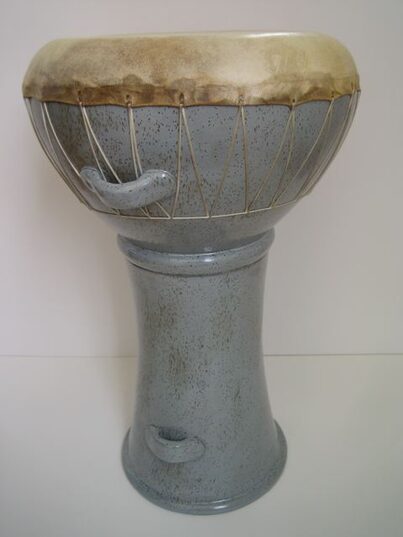
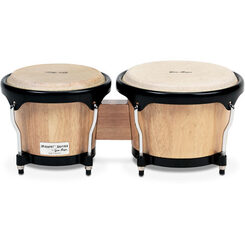
BONGOS come in sets of two or more drums, usually attached. They are more often played with the fingers rather than the hands, with the larger drum (usually placed to be played with the dominant hand) used to produce the deeper "bass" tones, and the smaller to produce the tones and slaps.
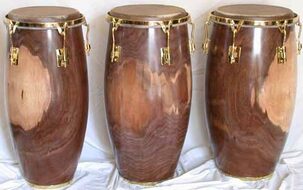
CONGAS are barrel-shaped and derived hand drums developed in Cuba. They usually come in sets of three, with the highest, middle, and lowest pitched drums called Quinto, Conga, and Tumba, respectively (see photo at right). Conga shells are made of wood or synthetic materials. The drumheads are traditionally made of cow hide, and are usually key-tuned. If you are considering a conga as your first drum, try to choose a middle-voiced conga with the widest tonal range possible.
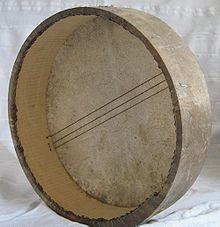
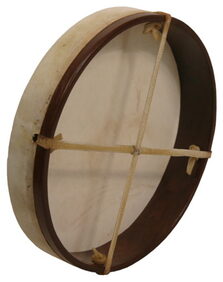
FRAME DRUMS are found in almost every corner of the world in one form or another. Technically speaking, any drum whose diameter is greater than its height is a frame drum. In its simplest form the drum consists of a membrane (head) stretched over a wooden frame or hoop. Refinements include the addition of wires or strings used as a snare in the bendir shown at the left, and a handle of ropes or hide on the Shaman drum shown at right.
Most frame drums are played either with the hands or using a beater, which in its simplest form is a stick with a padded ball on the end. The Irish bodhran (shown in the upper right corner of the montage below) is traditionally played with a wooden "tipper," which is a wooden tool held in the middle, with either end hitting the drum as the player "beats" the drum with a sideways motion. Bodhran playing also features using the nondominant hand to close off the drum tones by selectively placing the hand or thumb on the back of the drum head. The cross-bracing of the bodhran helps in this endeavor now, but expert players may consider it superfluous.
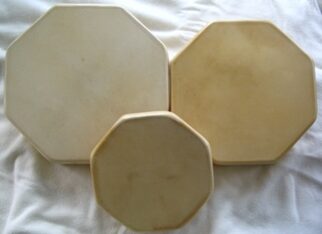 | 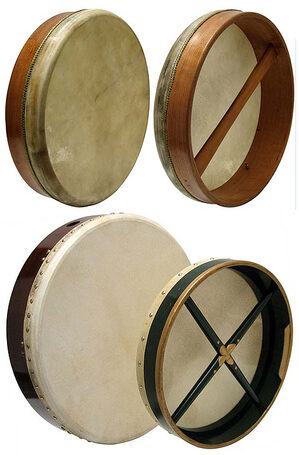 |
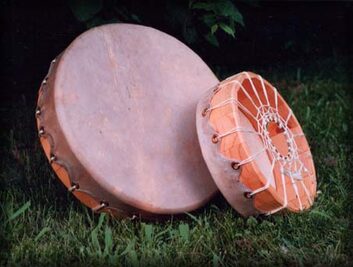 | 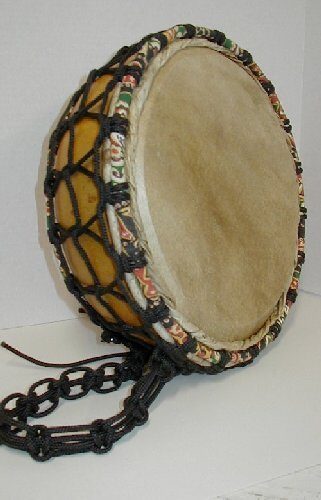 |
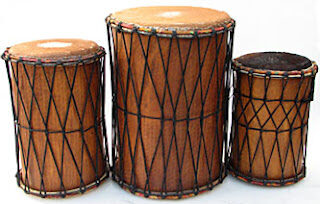
DJUN-DJUNS are large, 2-headed drums from Africa that are often played with djembes. They are usually suspended on their sides, and played with large beaters. They also may have cowbells mounted on their sides. Traditionally, there are three sizes of of djun-djuns, and within drum circles there is usually no more than one set. In drum circles, they are marvelous for keeping the pulse!
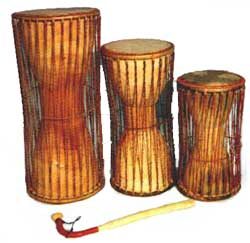
TALKING DRUMS are occasionally found in drum circles. They are fairly common throughout the world, and come in various sizes and configurations. They have two heads, and are played with a beater like the one shown at the the bottom of the picture to the right. They are held under the player's nondominant arm. While and after the head is struck with the beater, the pitch of the tone can be changed by squeezing and letting up on the ropes to change the pressure on the head (pretend you're squeezing the bag of a bagpipe).
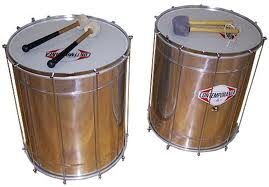 SURDOS are large bass drums that were developed in Brazil. They can be played standing on the floor when used in dancing or playing circles, or suspended from the shoulders when used for marching in processions or for providing a pulse rhythm for meditation and exercise circles. They are great for providing the pulse in a drum circle, and the hand can be used to mute a tone shortly after it is struck to provide a secondary rhythm. They come in several different sizes, and the hardware for allowing them to stand on the floor may be supplied separately.
SURDOS are large bass drums that were developed in Brazil. They can be played standing on the floor when used in dancing or playing circles, or suspended from the shoulders when used for marching in processions or for providing a pulse rhythm for meditation and exercise circles. They are great for providing the pulse in a drum circle, and the hand can be used to mute a tone shortly after it is struck to provide a secondary rhythm. They come in several different sizes, and the hardware for allowing them to stand on the floor may be supplied separately.
NOTE: Click HERE to go to Wikipedia's article on Drums. There is a list of lots of drums at the end of the article, each with an embedded link to a description of that drum. Explore to your heart's content!

